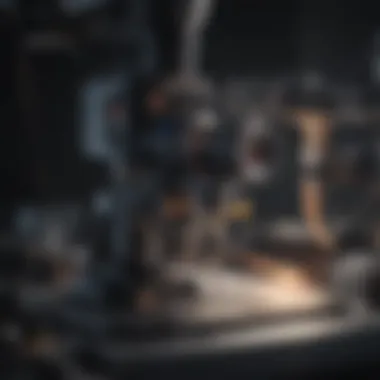Understanding Hyperspectral Microscopy: Insights and Applications


Intro
Hyperspectral microscopy stands at the forefront of modern imaging techniques, blending a wealth of spectral data with high spatial resolution to offer a multi-dimensional view of samples. This innovative approach has significant implications across various scientific disciplines, from biomedical research to materials science.
As we endeavor into the depths of this captivating field, it is crucial to grasp the underlying principles driving hyperspectral microscopy and recognize its growing importance. Not only does it illuminate complex biological processes, but it also enhances our ability to analyze materials with unparalleled precision. This article will navigate through the latest advancements, detailed methodologies, and practical applications, painting a comprehensive picture of hyperspectral microscopy’s role in today’s research ecosystem.
Recent Advances
Latest Discoveries
In the past few years, advancements in hyperspectral microscopy have led to several groundbreaking discoveries. One notable achievement is the use of this technology in live-cell imaging. For instance, integrating hyperspectral techniques enables researchers to observe biomolecular interactions within living cells without disrupting them. An exciting example is the work conducted on the molecular basis of diseases like Alzheimer’s, where scientists track the progress of protein aggregation in real-time.
Technological Innovations
Technological breakthroughs have significantly enhanced the capabilities of hyperspectral microscopy. New sensor technologies allow for greater precision in spectral measurements while reducing noise. The advent of compact spectrometers has made this technology more accessible in diverse settings, from academic research labs to industrial environments.
In addition, machine learning algorithms are increasingly being integrated into hyperspectral imaging systems. By automating data analysis, these systems can uncover patterns that might be difficult to identify through traditional methods, vastly improving the speed and accuracy of imaging results.
Methodology
Research Design
Understanding the methodology behind hyperspectral microscopy is crucial for effective application. Researchers typically employ a systematic approach where they define specific objectives, select appropriate samples, and choose suitable imaging parameters. The research design often starts with formulating hypotheses, followed by establishing a control setup for comparative analysis.
Data Collection Techniques
In hyperspectral microscopy, data collection is paramount. This process usually involves the collection of images across a wide range of wavelengths. Researchers utilize either point-scanning or wide-field imaging methods, depending on the desired outcome. Each technique presents unique advantages:
- Point-scanning allows for high-resolution imaging, capturing detailed spectral information from specific locations in a sample.
- Wide-field imaging, on the other hand, facilitates the rapid acquisition of spectral data over larger spatial areas, making it particularly useful for surveying extensive samples.
The collected data is often processed with specialized software to extract meaningful information. This may involve spectral unmixing to differentiate between overlapping signals and enhancing the overall image quality.
"Hyperspectral microscopy is more than just an imaging technique; it’s a bridge that connects the world of simplistic observation to a realm of intricate detail."
The End
In essence, hyperspectral microscopy represents a pivotal advancement in scientific imaging and analysis. By combining spectral data with spatial resolution, it empowers researchers and professionals to decode the complexities of the microscopic world with a level of detail that was once unimaginable. As we glance into the future, the continual evolution of this technology promises to unlock even greater potential, shaping the path for innovative discoveries in various fields.
Prelims to Hyperspectral Microscopy
In today's scientific landscape, hyperspectral microscopy stands out as a game changer. This technology merges imaging and spectroscopy, allowing researchers to gather detailed information about materials at unprecedented levels. By capturing wide spectral ranges at various spatial resolutions, hyperspectral microscopy serves many fields. This enhances our understanding of both biological systems and materials science.
Definition and Overview
Hyperspectral microscopy is a high-tech method that involves taking images across many wavelengths. Unlike simple imaging techniques that capture just the visible light spectrum, hyperspectral microscopy extends its reach into the infrared and ultraviolet regions. In essence, each pixel in a hyperspectral image contains a full spectrum of data rather than a single color. This rich information allows scientists to differentiate materials based on their spectral signatures.
Being able to characterize substances beyond what traditional microscopy offers is crucial in research and industry. It opens up new avenues in identifying and analyzing materials with precision. For example, in biomedical research, this method can discern different cell types or the presence of disease markers with impressive accuracy.
Historical Development


The journey of hyperspectral microscopy is quite fascinating. Its roots can be traced back to the early years of remote sensing in the 1980s. Scientists began to realize that the spectral information collected from aerial images could help in distinguishing different materials on Earth. As technology advanced, this concept was adapted to the microscope level.
By the late 1990s and early 2000s, hyperspectral imaging started being integrated into laboratory settings. Researchers began utilizing this method to explore complex biological samples, revealing details that standard techniques failed to uncover. Over the years, advancements in camera technology and data processing have vastly improved the efficacy and accessibility of hyperspectral microscopy. Today, it is used in diverse applications, from environmental monitoring to quality control in manufacturing.
"Hyperspectral imaging enables scientists to see more than just the surface; it allows a deeper understanding of material properties and behaviors."
In summary, hyperspectral microscopy combines sophisticated imaging with versatile applications across various fields. Its development reflects the ongoing quest to enhance our understanding of both the intricate world of biology and the expansive field of materials science. As we proceed deeper into the article, we will uncover the technical foundations, applications, challenges, and future directions of this innovative technology.
Technical Foundations
Understanding the technical foundations of hyperspectral microscopy is crucial for comprehending how this technology has carved out its niche in both research and applied science. These foundational elements not only underpin the functionality of the system but also pave the way for its expansive range of applications. Grasping the principles, instrumentation, data acquisition techniques, and processing methods is essential for researchers and professionals who aim to leverage hyperspectral microscopy in their work.
Principles of Hyperspectral Imaging
Hyperspectral imaging (HSI) operates on the principle of capturing images across a wide range of wavelengths simultaneously, offering a unique advantage over traditional imaging techniques. While standard cameras typically capture three primary colors—red, green, and blue—the hyperspectral method gathers data from hundreds of contiguous spectral bands. This enhanced spectral resolution enables the differentiation of materials based on their spectral signatures.
One key aspect of HSI is its ability to provide both spatial and spectral information in a single image. This dual-layered approach allows scientists to observe not only what the object looks like but also its chemical composition. For example, in biological imaging, a hyperspectral system can differentiate between healthy and diseased tissues based on their unique spectral characteristics.
Moreover, the principle of HSI is grounded in the interaction between light and matter. When light hits an object, different wavelengths are absorbed, reflected, or transmitted differently depending on the object's chemical makeup. This characteristic can be exploited to identify materials or biological entities effectively, making hyperspectral microscopy a potent tool in various fields.
Instrumentation and Components
The instrumentation involved in hyperspectral microscopy is intricate and tailored to capture high-resolution spectral data. Key components of these systems include:
- Light Sources: Often, a halogen or LED light source is employed to provide a controlled and consistent illumination across the spectrum.
- Cameras and Detectors: Specialized cameras are designed to capture hyperspectral data at high speeds. Common sensors include CCD (charge-coupled device) and EMCCD (electron multiplying CCD) for low-light scenarios, which enhance sensitivity and temporal resolution.
- Spectrometer: This device analyzes the spectral composition of the light reflected off or transmitted through the sample. It typically splits the incoming light into its component wavelengths for detailed analysis.
- Optical Systems: Lenses and other optical elements are critical for focusing light onto the detector while maintaining clarity and minimizing distortions.
The interconnection between these components significantly influences the performance of hyperspectral microscopy, dictating its resolution, sensitivity, and overall versatility in various applications.
Data Acquisition Techniques
Data acquisition in hyperspectral microscopy involves capturing a series of images across the different wavelengths, resulting in a three-dimensional data cube: two spatial dimensions (X and Y) and one spectral dimension (Z). Several techniques can be employed for effective data acquisition:
- Pushbroom Imaging: This method captures a continuous stream of spectral data as the sample moves past the imaging sensor. It’s akin to rolling a film camera down a moving walkway, allowing for high-throughput imaging but requiring precise calibration to ensure accuracy.
- Snapshot Hyperspectral Imaging: Unlike pushbroom, snapshot techniques capture all wavelengths at once. This approach typically employs advanced camera technology but may compromise resolution in some instances due to the complexity of simultaneous data capture.
- Spatial Scanning: This technique involves moving the sample or the optical focus across the area of interest while capturing spectra incrementally. While it's simpler, it can be time-consuming and susceptible to motion artifacts.
Data acquisition precision is paramount; any noise or error can lead to misinterpretations in analysis.
Data Processing and Analysis
Once data is acquired, the next crucial step is processing it for analysis. This phase involves various computational techniques and algorithms designed to extract meaningful information from the raw spectral data. Some common steps in this process include:
- Noise Reduction: Techniques such as filtering and averaging are employed to minimize noise which can obscure important signals in hyperspectral data.
- Spectral Unmixing: This method helps in breaking down composite spectral information into its individual components, facilitating better identification of materials or substances in complex samples.
- Dimensionality Reduction: Algorithms like PCA (Principal Component Analysis) can be utilized to reduce the volume of data while retaining essential features. This helps in better visualization and interpretation, especially when dealing with vast datasets.
- Machine Learning Techniques: Recently, AI has emerged as a powerful ally in analyzing hyperspectral data. Advanced algorithms can classify materials and detect patterns beyond human capabilities, revolutionizing the field of imaging and diagnostics.
In short, the ability to process and analyze data effectively is what gives hyperspectral microscopy its compelling edge in diverse applications, from understanding cellular processes to quality control in manufacturing.
Applications in Biology
The intersection of hyperspectral microscopy and biology has unlocked previously inconceivable avenues for exploration and discovery. This technology is not just an enhancement; it fundamentally alters how researchers interact with biological materials, elevating the ability to visualize minute details that traditional microscopy often overlooks. The capacity to integrate spectral signatures with spatial information enables scientists to paint a richer picture of biological processes in real time, and the advantages it brings are manifold.
Cellular Imaging
When it comes to cellular imaging, hyperspectral microscopy shines remarkably. One of the primary reasons for its importance is the detailed insight it provides into cellular components without the need for invasive techniques. In a typical scenario, scientists wish to investigate cellular phenomena, such as organelle dynamics or protein expression, marking significant events in a cell's life cycle.


Instead of relying solely on fluorescent markers or stains, which can sometimes alter cell physiology, hyperspectral microscopy allows for real-time observation by exploiting the natural spectral signatures of cellular structures. For instance, consider a researcher investigating cellular responses to environmental stressors. By capturing hyperspectral images, they can differentiate between healthy and stressed cells based on their unique spectral fingerprints. This not only aids in understanding the underlying biological mechanisms but also has significant implications in the field of regenerative medicine.
Tissue Analysis
Moving from cells to tissues, hyperspectral microscopy continues to impress. Tissue analysis is crucial in fields such as pathology and oncology. Traditional methods often require extensive processing and staining, which can introduce artifacts and mask true biological variations. Hyperspectral methods, however, allow for the examination of tissue samples with unparalleled precision.
Imagine examining a biopsy where the goal is to identify malignant tissues. Rather than relying solely on histological techniques, hyperspectral imaging can analyze the chemical composition of tissues. Varying absorption and reflection patterns in specific wavelengths highlight differences that signify disease progression or tissue anomaly. This capability enhances not only diagnostic accuracy but also the ability to monitor treatment efficacy in real time. The insight gained can help shape more personalized treatment plans.
Drug Discovery and Development
In the realm of drug discovery, hyperspectral microscopy plays a pivotal role that is transforming therapeutic development. It's clear that understanding how cells react to drugs is essential, not just for efficacy but also for toxicity. The ability to track cellular responses in real-time integrates seamlessly into the research process.
For instance, researchers can deploy hyperspectral imaging techniques to monitor the interactions between drug compounds and target cells. This technique allows for the capture of specific cellular responses based on spectral changes, leading to faster identification of promising drug candidates. In addition, it can streamline the screening process, reducing the reliance on conventional bioassays that are often time-consuming and resource-intensive. Amidst a competitive pharmaceutical landscape, such innovations can mean the difference between success and failure in developing lifesaving therapies.
"Hyperspectral microscopy is at the frontier of biological research, bridging the gap between visualization and real biological insight."
In summary, the applications of hyperspectral microscopy in biology are vast and profound. From enhancing our understanding of cellular dynamics to refining tissue analysis and expediting drug discovery, this robust technology stands to revolutionize how we approach biological research. The complexity it unveils does not merely serve academic curiosity; it has practical implications that could influence healthcare, wellness, and therapeutic outcomes for the better.
Applications in Materials Science
Hyperspectral microscopy has carved out a significant niche in materials science, amplifying the ability of researchers and professionals to discern minute differences within complex materials. The nuanced spectral data captured allows for superior analysis in comparisons to traditional techniques, enhancing both the quality of the insights gained and the efficiency of the testing processes. The following subsections delve into two pivotal applications of hyperspectral microscopy—characterization of nanomaterials and quality control in manufacturing—that clearly illustrate its transformative potential within the field.
Characterization of Nanomaterials
Characterizing nanomaterials is not just an academic exercise; it has tangible implications across various sectors including electronics, biomedical devices, and energy storage. Nanomaterials often exhibit unique optical properties, making them invaluable in applications ranging from targeted drug delivery to photovoltaics. Hyperspectral microscopy allows scientists to gather comprehensive spectral information from nanomaterials across multiple wavelengths, providing insight into their composition and structure.
Using this technique, researchers can:
- Identify chemical compositions of nanoscale materials.
- Investigate morphological characteristics at unprecedented resolutions.
- Analyze surface defects that might affect performance.
For instance, when studying quantum dots or nanoparticles, hyperspectral imaging can reveal distribution patterns and variations in size that could affect their efficacy in applications. This level of detail helps in tailoring materials for specific uses more effectively than conventional microscopy methods.
"The ability to assess nanomaterials at such granular detail transforms how we design and utilize cutting-edge materials."
Quality Control in Manufacturing
In today's fast-paced manufacturing environments, ensuring product quality cannot be overstated. Here, hyperspectral microscopy plays a vital role by providing non-destructive testing capabilities that traditional methods often lack. Manufacturers can utilize hyperspectral techniques to:
- Monitor material composition in real time during production.
- Detect contaminants or inconsistencies that may impact product reliability.
- Improve process efficiency by identifying issues early in the production cycle.
In environments where precision is key, such as in semiconductor manufacturing or composite material production, having the ability to visualize and analyze variations at both micro and macro scales is invaluable. This leads to a notable decrease in waste and rework, saving both time and resources. Additionally, integrating hyperspectral analysis with traditional methods can significantly amplify overall quality assurance frameworks, setting benchmarks that elevate industry standards.
In summary, the applications of hyperspectral microscopy in materials science not only enhance characterization and quality control processes but also serve as a bridge to future innovations. As technology advances, its influence will only continue to deepen, shaping the way materials are developed, utilized, and understood.
Comparative Analysis with Traditional Microscopy Methods
When delving into hyperspectral microscopy, it's essential to examine how this innovative technique stands in contrast to the more conventional microscopy methods that have been relied upon for decades. This comparative analysis not only highlights the evolving landscape of imaging techniques but also emphasizes the potential hyperspectral microscopy has to surpass traditional modalities, ushering in advancements across various scientific fields.
Advantages of Hyperspectral Microscopy
Hyperspectral microscopy brings several strong advantages to the table compared to traditional light microscopy techniques. The most notable of these include:


- Rich Data Collection: Hyperspectral microscopy captures both spatial and spectral information simultaneously, furnishing researchers with a comprehensive dataset that aids in deeper analysis.
- Enhanced Contrast and Resolution: This technique tends to excel in distinguishing subtle differences in materials and biological specimens, which often slip past the detection of standard microscopy.
- Non-destructive Imaging: Unlike some traditional methods that may alter or damage samples, hyperspectral microscopy offers a non-invasive way to analyze samples, thus preserving their integrity for further study.
- Versatility Across Applications: Whether it's in biological systems or material sciences, hyperspectral microscopy can be adapted to various sample types and analytical requirements, heightening its utility in diverse research scenarios.
In essence, these benefits signify a leap forward in imaging capabilities, offering possibilities that traditional methodologies simply cannot provide.
Limitations and Challenges
Despite its noteworthy advantages, hyperspectral microscopy does have its share of limitations and challenges that merit consideration. Key points to keep in mind include:
- Cost and Accessibility: The high cost of hyperspectral systems can act as a barrier for many institutions, making traditional methods more preferable due to their lower initial investment and maintenance costs.
- Complex Data Processing: The sheer volume of data generated in hyperspectral imaging necessitates sophisticated data processing algorithms. This can pose a learning curve for researchers unfamiliar with advanced data analysis techniques.
- Limited Depth Penetration: Hyperspectral imaging struggles with depth penetration compared to techniques like confocal microscopy. This limitation can restrict its applicability in thicker or denser samples.
- Operator Dependency: The proficiency of the operator significantly impacts the effectiveness of hyperspectral systems. Training and expertise are critical in achieving optimal results in hyperspectral applications.
Future Directions in Hyperspectral Microscopy
Hyperspectral microscopy stands at the crossroads of advanced imaging techniques and analytical methodologies. As this field continues to evolve, some exciting avenues lie ahead. The future directions of hyperspectral microscopy not only highlight its potential but also the pressing need to integrate new technologies and approaches. They promise to transform how we collect, analyze, and interpret data across various domains.
Emerging Technologies
As the old saying goes, "necessity is the mother of invention," and that sentiment rings especially true in the realm of hyperspectral microscopy. Several innovative technologies are on the horizon, allowing for enhanced capabilities.
- Optical Design Improvements: Utilizing advanced optical systems such as reflective optics can enhance resolution, allowing for better spatial accuracy.
- Miniaturization of Sensors: With continuous advancements in sensor design, miniaturized hyperspectral sensors are becoming more feasible. This is of particular interest for field studies, reducing the footprint while preserving quality.
- Flexible Imaging Systems: Technologies such as metasurfaces could enable flexible imaging systems that adapt to a variety of environments and applications.
These emerging technologies not only aim to improve imaging quality but also increase the accessibility of hyperspectral methods to a wider audience across diverse disciplines.
Potential Advancements in Applications
As we gaze into the future, the applications of hyperspectral microscopy seem to be boundless. Researchers are beginning to identify new areas where hyperspectral techniques could be utilized.
- Environmental Monitoring: Hyperspectral microscopy can be used to monitor pollutants or changes in ecosystems, providing vital information for ecological studies.
- Agricultural Assessments: By analyzing plant health through hyperspectral imaging, farmers can make more informed decisions, leading to better yields.
- Tissue Engineering: In the biomedical field, hyperspectral techniques could be pivotal for early disease detection by providing more granular data on tissue composition.
With these potential advancements, the demand for hyperspectral microscopy is likely to rise, promoting innovation and further research.
Integration with Artificial Intelligence
The marriage of hyperspectral microscopy with artificial intelligence represents one of the most promising advancements in the field. Integrating these two domains allows for more efficient data processing and interpretation, which is crucial given the extensive datasets generated by hyperspectral systems.
- Machine Learning Algorithms: AI-driven algorithms can help classify and analyze hyperspectral images with remarkable accuracy. This has applications in various sectors, from agriculture to pathology.
- Real-time Analysis: Using AI for real-time analysis enables immediate decision-making processes. This is especially beneficial in time-critical applications, such as surgical procedures or quality control in manufacturing.
- Predictive Modelling: AI can assist in building predictive models based on hyperspectral data, facilitating the exploration of new materials or biological responses under different conditions.
The integration of artificial intelligence not only streamlines analysis but could also open doors to entirely new methodologies and applications in hyperspectral microscopy.
End
In wrapping up the discussion surrounding hyperspectral microscopy, it’s vital to underscore the significant impact this innovative technology holds in various scientific arenas. The technology bridges the gap between spectral data and spatial analysis, offering a unique lens through which to view and interpret samples. This is not merely about high-tech machinery and complex algorithms; it is about unveiling layers of information that traditional microscopy often overlooks.
Summary of Key Insights
To distill the essence of what has been explored, here are some of the key insights:
- Multidimensional Data: Hyperspectral microscopy captures numerous spectral bands for every pixel, allowing for a detailed examination of samples at molecular levels.
- Versatility: Its applications cut across biology, materials science, and beyond, showcasing the technique’s adaptability.
- Integration with AI: The potential for artificial intelligence to enhance data interpretation marks a new frontier for hyperspectral microscopy, making processes faster and more efficient.
- Challenges: Despite its benefits, users must navigate challenges like data processing complexities and equipment costs.
This comprehensive overview illustrates that hyperspectral microscopy is not just a passing phase in imaging technology. Its foundational principles provide researchers and professionals with tools to dissect and understand biological mechanisms, materials' properties, and more, offering opportunities for breakthrough discoveries.
Final Thoughts on the Impact of Hyperspectral Microscopy
As we reflect on the discussions throughout the article, it is clear that hyperspectral microscopy stands at the threshold of scientific advancement. The profound implications it harbors suggest that this technology can truly redefine how we observe and analyze the microscopic world.
"The future of hyperspectral microscopy is not just about what we see now but what we will discover next."
The synergy between this method and emerging technologies paves the way for exciting developments in research protocols. It opens doors to avenues previously considered unreachable in both academic and industrial settings. In essence, embracing hyperspectral microscopy now could mean being at the forefront of innovations that significantly broaden our understanding of the natural and synthetic worlds around us.















